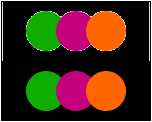Colors
In this article, I'll talk about how to use color for different theme & interiors and how color effect on humans behavior & mood.
Color in design is very subjective. What evokes one reaction in one person may evoke a very different reaction in someone else. Sometimes this is due to personal preference, and other times due to cultural background. Color theory is a science in itself. Studying how colors affect different people, either individually or as a group, is something some people build their careers on. And there’s a lot to it. Something as simple as changing the exact hue or saturation of a color can evoke a completely different feeling. Cultural differences mean that something that’s happy and uplifting in one country can be depressing in another.

COLORS IS AN EMOTION :- – In simple language color is the name given to the reflections of wavelengths of different surfaces.

V – Voilet
I – Indigo
B - Blue
G - Green
Y - Yellow
O- Orange
R - Red
--------------TYPE OF COLORS--------------
1. Primary Colors
RED, YELLOW & BLUE

2. Secondary Colors
Orange, Violet & Green
3. Tertiary Colors
Red-orange, yellow –orange ,Yellow-Green ,Blue- Green, Blue-violet, Red- Violet.
--------------CHARACTERISTICS OF COLORS--------------
1. Hue
2. Value
3. Saturation or Chroma.
1. Hue - It is the classification of a color by name RED-YELLOW & BLUE, are Primary Hues, ORANGE,GREEN & VIOLET
are Secondary Hues ,Inter-mixture of Primary & Secondary Hues produces Tertiary Colors-Red-orange, yellow –orange ,Yellow-Green ,Blue- Green, Blue-violet,Red- Violet.

2. Value – In color classification it is the lightness or darkness of hue produced byintroduction of Black or White Color intermixed with Primary ,secondary,or Tertiary Color.
(i) Tints- are made by mixing of white color.
(ii) Shades- are made by intermixing of Black Color sometimes called Tones.

3. Saturation or Chroma - Saturation is the purity of a color. High saturation colors look rich and full. Low saturation colors look dull and grayish.

--------------PSYCHOLOGICAL ASPECT OF COLORS--------------
The eye is the tool for feeling sight. Sensing colors is affected by a number of physical phenomena which can give comfortable effects that balances psychological visual of human-being.

Red is associated with blood, and with feelings that are energetic, exciting, passionate . Most colors carry both positive and negative implications. The downside of red evokes aggressive feelings, suggesting anger or violence.
Orange is the color of flesh, or the friendly warmth of the hearth fire. The positive implications of this color suggest approach ability, informality. The negative side might imply accessibility to the point of suggesting that anyone can approach-- a lack of discrimination or quality.
Yellow is the color of sunshine. This color is optimistic, upbeat, modern. The energy of yellow can become overwhelming. Therefore yellow is not a color that tends to dominate fashion for long periods of time.
Green In its positive mode, green suggests nature (plant life, forests), life, stability, restfulness, naturalness. On the other hand, green in some tones or certain contexts (such as green skin) might instead suggest decay (fungus, mold), toxicity, artificiality.
Blue suggests coolness, distance, spirituality, or perhaps reserved elegance. Some shade of blue is flattering to almost anyone. In its negative mode, we can think of the "blues"-the implication being one of sadness, passivity, alienation, or depression.
Violet is the color of fantasy, playfulness, impulsiveness, and dream states. In its negative mode, it can suggest nightmares, or madness.
--------------COLOR SCHEMES--------------
Color scheme is the choice of colors used in design for a range of media. Color schemes are used to create style and appeal. Colors that create an aesthetic feeling when used together will commonly accompany each other in color schemes. A basic color scheme will use two colors that look appealing together. Color schemes are classified by how the colors relate to each other on the color wheel.
Types of Color Schemes
1. Analogous Color Scheme
2. Complementary Color Scheme
3. Split Complimentary
4. Monochromatic Color Scheme
5. Triad
1. Analogous Color Scheme
The analogous color scheme is very similar to the monochromatic scheme. Instead of using tints and shades of one color, you use three to five colors that are right next to each other on the color wheel. These colors will look good together because they are not very different from each other. Similarly, you can use a color scheme that uses only the warm colors or only the cool colors.




2. Complementary Color Scheme
The complementary color scheme simply uses colors that are opposite one another on the color wheel. This creates a bold difference between the colors, which makes them stand out.




3. Split Complimentary
A split complementary color scheme takes the power of the complementary colors just left of center. Well actually, left and right of center. To get a split complementary scheme, select your color, and then look to the color wheel for its complement. Then look at the colors that border the complement on each side.


4. Monochromatic Color Scheme
This scheme is simple. Mono meaning one. Chroma meaning color. Hence a monochromatic color scheme uses only one color. This sounds pretty dull, but you can do some interesting things with it. In monochromatic designs, you are still able to use all the tints and shades of the color you select. While it seems limiting, working within the limits of a monochromatic color scheme encourages you to get creative with other aspects of the design.


5. Traid
Triadic is based on three colors that are equal distances apart on the color wheel. If you draw lines to connect the three colors, it will form a triangle. Triadic colors go well together, yet still distinctly contrast.


*****






















Comments